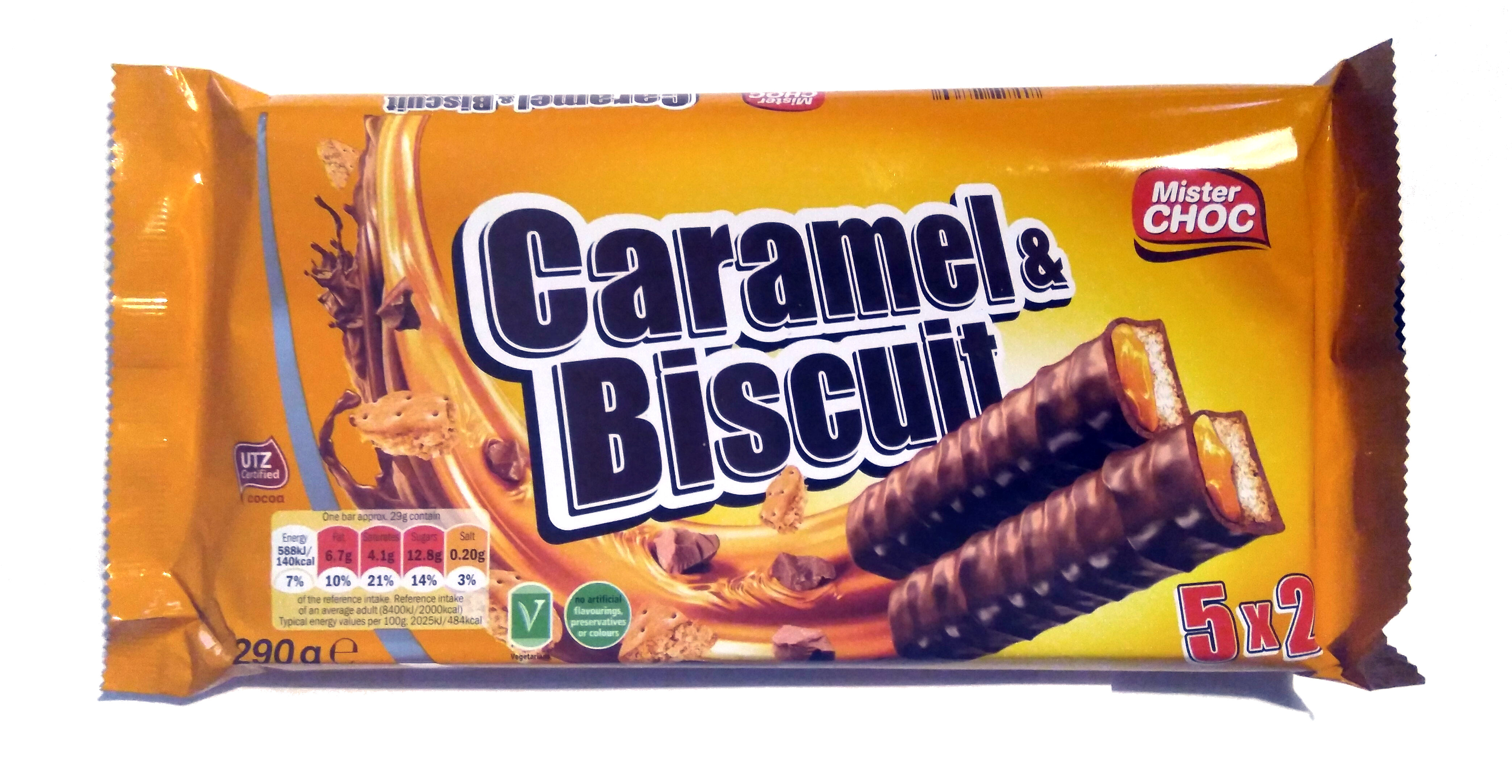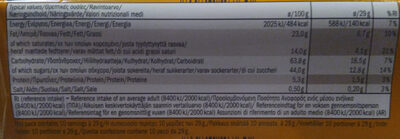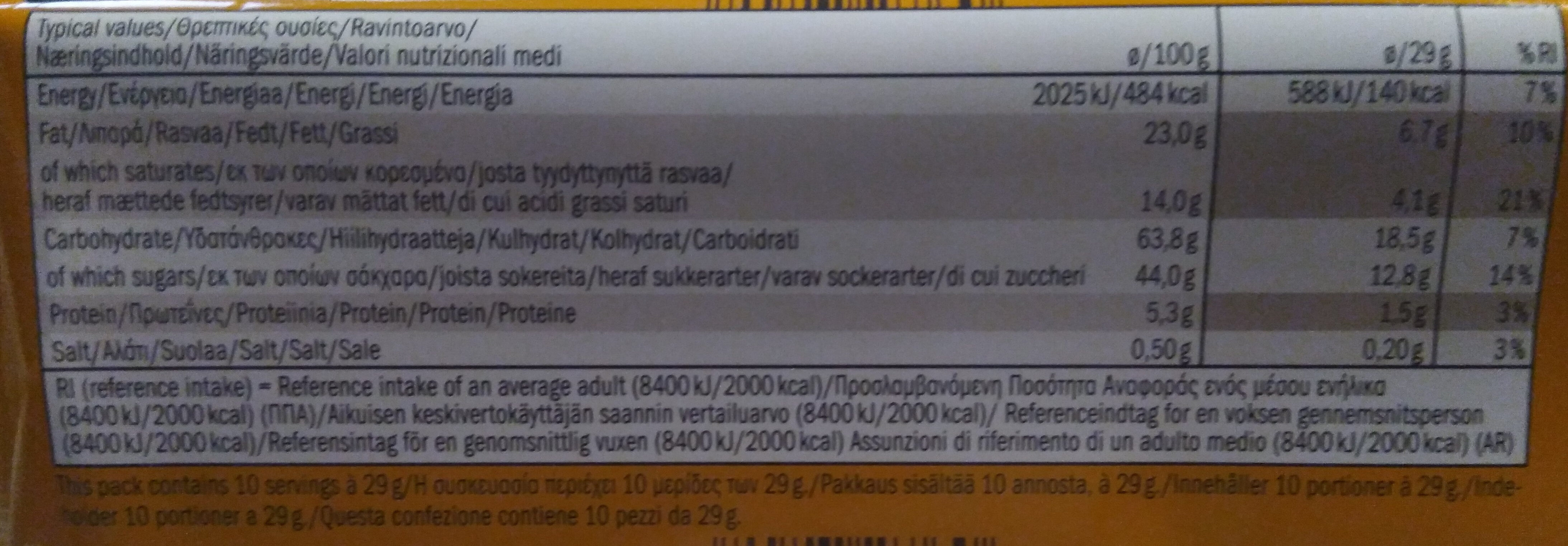Help us make food transparency the norm!
As a non-profit organization, we depend on your donations to continue informing consumers around the world about what they eat.
The food revolution starts with you!
Caramel & Biscuit - Mister Choc - 58g
Caramel & Biscuit - Mister Choc - 58g
Ambiguous barcode: This product has a Restricted Circulation Number barcode for products within a company. This means that different producers and stores can use the same barcode for different products.
×
This product page is not complete. You can help to complete it by editing it and adding more data from the photos we have, or by taking more photos using the app for Android or iPhone/iPad. Thank you!
×
Streckkod: 20272760
Kvantitet: 58g
Förpackning: Plast, PP 5 - polypropen
Varumärken: Mister Choc, Ludwig Schokolade, Krüger
Kategorier: Snacks, Söta snacks, en:Cocoa and its products, Konfekt, en:Bars, Kakor och tårtor, Chokladgodis, Kex, en:Chocolate biscuits, en:bars-covered-with-chocolate, en:Caramels
Etiketter, certifieringar, utmärkelser:
Fair trade, Fairtrade cocoa, Triman
Tillverknings eller bearbetningsplats: Germany
Butiker: Lidl
Länder där såld: Danmark, Finland, Frankrike, Tyskland, Grekland, Italien, Polen, Sverige
Matching with your preferences
Hälsa
Ingredienser
-
35 ingredienser
socker, vetemjöl, palmfett, glukossirap, kakaosmör, kondenserat skummjölk, helmjölkspulver, kakaomassa, fuktighetsbevarande medel (sorbitolsirap), laktos, vasslepulver, karamellsockersirap, salt, gräddpulver, emulgeringsmedel (sojalecitin), fettreducerat kakaopulver, kornmaltsextrakt, bakpulver (natriumvätekarbonat), vaniljextrakt. Minst 27 % kakao i mjölkchokladen. Kan innehålla spår av jordnötter, andra nötter och ägg.Allergener: Gluten, Mjölk, SojaSpår: Ägg, Nötter, Jordnöt
Food processing
-
Ultra processed foods
Elements that indicate the product is in the 4 - Ultra bearbetade livsmedel och drycker group:
- Tillsats: E420 - Sorbitol
- Ingrediens: Fuktighetsbevarande medel
- Ingrediens: Laktos
Food products are classified into 4 groups according to their degree of processing:
- Obearbetade eller minimalt bearbetade livsmedel
- Bearbetade kulinariska ingredienser
- Halvfabrikat
- Ultra processed foods
The determination of the group is based on the category of the product and on the ingredients it contains.
Tillsatser
-
E420 - Sorbitol
Sorbitol: Sorbitol --, less commonly known as glucitol --, is a sugar alcohol with a sweet taste which the human body metabolizes slowly. It can be obtained by reduction of glucose, which changes the aldehyde group to a hydroxyl group. Most sorbitol is made from corn syrup, but it is also found in nature, for example in apples, pears, peaches, and prunes. It is converted to fructose by sorbitol-6-phosphate 2-dehydrogenase. Sorbitol is an isomer of mannitol, another sugar alcohol; the two differ only in the orientation of the hydroxyl group on carbon 2. While similar, the two sugar alcohols have very different sources in nature, melting points, and uses.Källa: Wikipedia (Engelska)
Ingrediensanalys
-
Palmolja innehåll okänt
Okända ingredienser: en:de-biscuit-et-33-de-caramel-enrobes-de-36-de-chocolat-au-lait, en:ingredients, en:sucre, en:farine-de-ble, en:graisse-de-palme, en:sirop-de-glucose, en:beurre-de-cacao, en:lait-concentre-ecreme, en:lait-en-poudre-entier, en:pate-de-cacao, en:lactoserum-doux-en-poudre, en:lait, en:sirop-de-sucre-caramelise, en:sel-de-cuisine, en:emulsifiant, en:lecithines, en:cacao-maigre-en-poudre, en:extrait-de-malt-d-orge, en:poudre-a-lever, en:carbonates-de-sodium, en:extrait-de-vanille, en:chocolat-au-lait, en:matiere-seche-issue-du-lait, en:peut-contenir-des-traces-d-arachides, en:de-fruits-a-coque, en:et-d-oeuf, en:a-conserver-a-l-abri-de-la-chaleur-et-de-l-humidite, en:➤-le-cacao-certifie-fairtrade-peut-etre-melange-avec-du-cacao-non-certifie-selon-le-principe-du-bilan-de-masse, en:en-savoir-plus, en:www-info-fairtrade-net, en:sourcingVissa ingredienser kunde inte kännas igen.
Vi behöver din hjälp!
You can help us recognize more ingredients and better analyze the list of ingredients for this product and others:
- Edit this product page to correct spelling mistakes in the ingredients list, and/or to remove ingredients in other languages and sentences that are not related to the ingredients.
- Add new entries, synonyms or translations to our multilingual lists of ingredients, ingredient processing methods, and labels.
If you would like to help, join the #ingredients channel on our Slack discussion space and/or learn about ingredients analysis on our wiki. Thank you!
-
Icke-vegan
Non-vegan ingredients: LaktosVissa ingredienser kunde inte kännas igen.
Vi behöver din hjälp!
You can help us recognize more ingredients and better analyze the list of ingredients for this product and others:
- Edit this product page to correct spelling mistakes in the ingredients list, and/or to remove ingredients in other languages and sentences that are not related to the ingredients.
- Add new entries, synonyms or translations to our multilingual lists of ingredients, ingredient processing methods, and labels.
If you would like to help, join the #ingredients channel on our Slack discussion space and/or learn about ingredients analysis on our wiki. Thank you!
-
Vegetarisk status okänd
Okända ingredienser: en:de-biscuit-et-33-de-caramel-enrobes-de-36-de-chocolat-au-lait, en:ingredients, en:sucre, en:farine-de-ble, en:graisse-de-palme, en:sirop-de-glucose, en:beurre-de-cacao, en:lait-concentre-ecreme, en:lait-en-poudre-entier, en:pate-de-cacao, en:lactoserum-doux-en-poudre, en:lait, en:sirop-de-sucre-caramelise, en:sel-de-cuisine, en:emulsifiant, en:lecithines, en:cacao-maigre-en-poudre, en:extrait-de-malt-d-orge, en:poudre-a-lever, en:carbonates-de-sodium, en:extrait-de-vanille, en:chocolat-au-lait, en:matiere-seche-issue-du-lait, en:peut-contenir-des-traces-d-arachides, en:de-fruits-a-coque, en:et-d-oeuf, en:a-conserver-a-l-abri-de-la-chaleur-et-de-l-humidite, en:➤-le-cacao-certifie-fairtrade-peut-etre-melange-avec-du-cacao-non-certifie-selon-le-principe-du-bilan-de-masse, en:en-savoir-plus, en:www-info-fairtrade-net, en:sourcingVissa ingredienser kunde inte kännas igen.
Vi behöver din hjälp!
You can help us recognize more ingredients and better analyze the list of ingredients for this product and others:
- Edit this product page to correct spelling mistakes in the ingredients list, and/or to remove ingredients in other languages and sentences that are not related to the ingredients.
- Add new entries, synonyms or translations to our multilingual lists of ingredients, ingredient processing methods, and labels.
If you would like to help, join the #ingredients channel on our Slack discussion space and/or learn about ingredients analysis on our wiki. Thank you!
-
Details of the analysis of the ingredients
Vi behöver din hjälp!
Vissa ingredienser kunde inte kännas igen.
Vi behöver din hjälp!
You can help us recognize more ingredients and better analyze the list of ingredients for this product and others:
- Edit this product page to correct spelling mistakes in the ingredients list, and/or to remove ingredients in other languages and sentences that are not related to the ingredients.
- Add new entries, synonyms or translations to our multilingual lists of ingredients, ingredient processing methods, and labels.
If you would like to help, join the #ingredients channel on our Slack discussion space and/or learn about ingredients analysis on our wiki. Thank you!
: de biscuit et 33% de caramel enrobés de 36% de chocolat au lait 31%, Ingrédients (sucre), farine de blé, graisse de palme, sirop de glucose, beurre de cacao, lait concentré écrémé, lait en poudre entier, pâte de cacao, humectant (sorbitols), lactose, lactosérum doux en poudre (lait), sirop de sucre caramélisé, sel de cuisine, émulsifiant (lécithines), cacao maigre en poudre, extrait de malt d'orge, poudre à lever (carbonates de sodium), extrait de vanille, Chocolat au lait 27% (cacao), matière sèche issue du lait 14% (Peut contenir des traces d'arachides), de fruits à coque, et d'œuf, À conserver à l'abri de la chaleur et de l'humidité, ➤ Le cacao certifié Fairtrade peut être mélangé avec du cacao non certifié selon le principe du bilan de masse, En savoir plus (www.info.fairtrade.net, sourcing)- de biscuit et 33% de caramel enrobés de 36% de chocolat au lait -> en:de-biscuit-et-33-de-caramel-enrobes-de-36-de-chocolat-au-lait - percent: 31
- Ingrédients -> en:ingredients
- sucre -> en:sucre
- farine de blé -> en:farine-de-ble
- graisse de palme -> en:graisse-de-palme
- sirop de glucose -> en:sirop-de-glucose
- beurre de cacao -> en:beurre-de-cacao
- lait concentré écrémé -> en:lait-concentre-ecreme
- lait en poudre entier -> en:lait-en-poudre-entier
- pâte de cacao -> en:pate-de-cacao
- humectant -> en:humectant
- sorbitols -> en:e420 - vegan: yes - vegetarian: yes
- lactose -> en:lactose - vegan: no - vegetarian: yes
- lactosérum doux en poudre -> en:lactoserum-doux-en-poudre
- lait -> en:lait
- sirop de sucre caramélisé -> en:sirop-de-sucre-caramelise
- sel de cuisine -> en:sel-de-cuisine
- émulsifiant -> en:emulsifiant
- lécithines -> en:lecithines
- cacao maigre en poudre -> en:cacao-maigre-en-poudre
- extrait de malt d'orge -> en:extrait-de-malt-d-orge
- poudre à lever -> en:poudre-a-lever
- carbonates de sodium -> en:carbonates-de-sodium
- extrait de vanille -> en:extrait-de-vanille
- Chocolat au lait -> en:chocolat-au-lait - percent: 27
- cacao -> en:cocoa - vegan: yes - vegetarian: yes - ciqual_proxy_food_code: 18100
- matière sèche issue du lait -> en:matiere-seche-issue-du-lait - percent: 14
- Peut contenir des traces d'arachides -> en:peut-contenir-des-traces-d-arachides
- de fruits à coque -> en:de-fruits-a-coque
- et d'œuf -> en:et-d-oeuf
- À conserver à l'abri de la chaleur et de l'humidité -> en:a-conserver-a-l-abri-de-la-chaleur-et-de-l-humidite
- ➤ Le cacao certifié Fairtrade peut être mélangé avec du cacao non certifié selon le principe du bilan de masse -> en:➤-le-cacao-certifie-fairtrade-peut-etre-melange-avec-du-cacao-non-certifie-selon-le-principe-du-bilan-de-masse
- En savoir plus -> en:en-savoir-plus
- www.info.fairtrade.net -> en:www-info-fairtrade-net
- sourcing -> en:sourcing
Näring
-
Bad nutritional quality
⚠ ️Varning: mängden fibrer är inte angiven, eventuella positiv inverkan på betyget kunde inte beaktas.⚠ ️Warning: the amount of fruits, vegetables and nuts is not specified on the label, it was estimated from the list of ingredients: 0This product is not considered a beverage for the calculation of the Nutri-Score.
Positiva poäng: 0
- Proteiner: 3 / 5 (värde: 5, avrundat värde: 5)
- Fiber: 0 / 5 (värde: 0, avrundat värde: 0)
- Frukt, grönsaker, nötter och raps- / valnöt- / olivoljor: 0 / 5 (värde: 0, avrundat värde: 0)
Negativa poäng: 27
- Energi: 6 / 10 (värde: 2073, avrundat värde: 2073)
- Socker: 9 / 10 (värde: 41.8, avrundat värde: 41.8)
- Mättat fett: 10 / 10 (värde: 14.3, avrundat värde: 14.3)
- Natrium: 2 / 10 (värde: 268, avrundat värde: 268)
The points for proteins are not counted because the negative points are greater or equal to 11.
Näringsvärde: (27 - 0)
Nutri-Score:
-
Näringsvärden
-
Fett i hög kvantitet (25.1%)
What you need to know- A high consumption of fat, especially saturated fats, can raise cholesterol, which increases the risk of heart diseases.
Recommendation: Limit the consumption of fat and saturated fat- Choose products with lower fat and saturated fat content.
-
Mättat fett i hög kvantitet (14.3%)
What you need to know- A high consumption of fat, especially saturated fats, can raise cholesterol, which increases the risk of heart diseases.
Recommendation: Limit the consumption of fat and saturated fat- Choose products with lower fat and saturated fat content.
-
Sockerarter i hög kvantitet (41.8%)
What you need to know- A high consumption of sugar can cause weight gain and tooth decay. It also augments the risk of type 2 diabetes and cardio-vascular diseases.
Recommendation: Limit the consumption of sugar and sugary drinks- Sugary drinks (such as sodas, fruit beverages, and fruit juices and nectars) should be limited as much as possible (no more than 1 glass a day).
- Choose products with lower sugar content and reduce the consumption of products with added sugars.
-
Salt i måttlig kvantitet (0.67%)
What you need to know- A high consumption of salt (or sodium) can cause raised blood pressure, which can increase the risk of heart disease and stroke.
- Many people who have high blood pressure do not know it, as there are often no symptoms.
- Most people consume too much salt (on average 9 to 12 grams per day), around twice the recommended maximum level of intake.
Recommendation: Limit the consumption of salt and salted food- Reduce the quantity of salt used when cooking, and don't salt again at the table.
- Limit the consumption of salty snacks and choose products with lower salt content.
-
-
Näringsfakta
Näringsfakta Som såld
för 100 g / 100 mlSom såld
per portion (29 g)Compared to: en:bars-covered-with-chocolate Energi 2 073 kj
(495 kcal)601 kj
(144 kcal)−1 % Fett 25,1 g 7,28 g −3 % Mättat fett 14,3 g 4,15 g +4 % Kolhydrat 62,2 g 18 g +5 % Sockerarter 41,8 g 12,1 g −13 % Fiber ? ? Protein 5 g 1,45 g −20 % Salt 0,67 g 0,194 g +77 % Fruits‚ vegetables‚ nuts and rapeseed‚ walnut and olive oils (estimate from ingredients list analysis) 0 % 0 %
Miljö
-
Eco-Score C - Måttlig miljöpåverkan
The Eco-Score is an experimental score that summarizes the environmental impacts of food products.→ The Eco-Score was initially developped for France and it is being extended to other European countries. The Eco-Score formula is subject to change as it is regularly improved to make it more precise and better suited to each country.Life cycle analysis
-
Average impact of products of the same category: C (Score: 56/100)
Kategori: Biscuit (cookie), with chocolate, prepacked
Kategori: Biscuit (cookie), with chocolate, prepacked
- PEF environmental score: 0.47 (the lower the score, the lower the impact)
- including impact on climate change: 5.92 kg CO2 eq/kg of product
Stage Impact Jordbruk
63.6 %Bearbetar
29.8 %Förpackning
2.3 %Transportation
3.2 %Distribution
1.0 %Consumption
0.0 %
Bonuses and maluses
-
Missing origins of ingredients information
Malus: -5
⚠ ️ The origins of the ingredients of this product are not indicated.
If they are indicated on the packaging, you can modify the product sheet and add them.
If you are the manufacturer of this product, you can send us the information with our free platform for producers.
-
Packaging with a medium impact
Malus: -8
Form Material Återvinning Impact Okänd PP 5 - polypropen Hög ⚠ ️ The information about the packaging of this product is not sufficiently precise (exact shapes and materials of all components of the packaging).⚠ ️ For a more precise calculation of the Eco-Score, you can modify the product page and add them.
If you are the manufacturer of this product, you can send us the information with our free platform for producers.
Eco-Score for this product
-
Impact for this product: C (Score: 43/100)
Produkt: Caramel & Biscuit - Mister Choc - 58g
Life cycle analysis score: 56
Sum of bonuses and maluses: -13
Final score: 43/100
-
Carbon footprint
-
Equal to driving 3.1 km in a petrol car
592 g CO² per 100g of product
The carbon emission figure comes from ADEME's Agribalyse database, for the category: Biscuit (cookie), with chocolate, prepacked (Source: ADEME Agribalyse Database)
Stage Impact Jordbruk
52.9 %Bearbetar
42.0 %Förpackning
1.9 %Transportation
2.9 %Distribution
0.3 %Consumption
0.0 %
Förpackning
-
Packaging with a medium impact
-
Packaging parts
(PP 5 - polypropen)
-
Packaging materials
Material % Packaging weight Packaging weight per 100 g of product Plast
-
Transportation
-
Origins of ingredients
Missing origins of ingredients information
⚠ ️ The origins of the ingredients of this product are not indicated.
If they are indicated on the packaging, you can modify the product sheet and add them.
If you are the manufacturer of this product, you can send us the information with our free platform for producers.Add the origins of ingredients for this product Add the origins of ingredients for this product
Report a problem
-
Incomplete or incorrect information?
Category, labels, ingredients, allergens, nutritional information, photos etc.
If the information does not match the information on the packaging, please complete or correct it. Open Food Facts is a collaborative database, and every contribution is useful for all.
Datakällor
Produkt tillagd den av teolemon
Senast ändrad produktsida på av prepperapp.
Produktsida också redigerad av alpha-lin, date-limite-app, ecoscore-impact-estimator, foodrepo, itec, jumati, kiliweb, openfoodfacts-contributors, packbot, pyrka, roboto-app, sil, tacite-mass-editor, twoflower, wojciech-dopieralski-op-pl, yuka.VzVnZlFLOEJoOUl4c01Jai9oVHN5NEpQeDVLSFdYSzNEYmNTSWc9PQ, yuka.WWJJeUFQMHM5cUF2Zy9GdTVobmw2LzllN2JTd1JUdW5Fc1JMSUE9PQ, yuka.WnBBcEFiWUJpOTh0cXNWazdoWFExdk5RNmMvNFVVZVJkcnNxSVE9PQ, yuka.sY2b0xO6T85zoF3NwEKvlndsDoPcuBvELg7Wwk-N_82TN7HKXe9i65nmDKs, yukafix.










